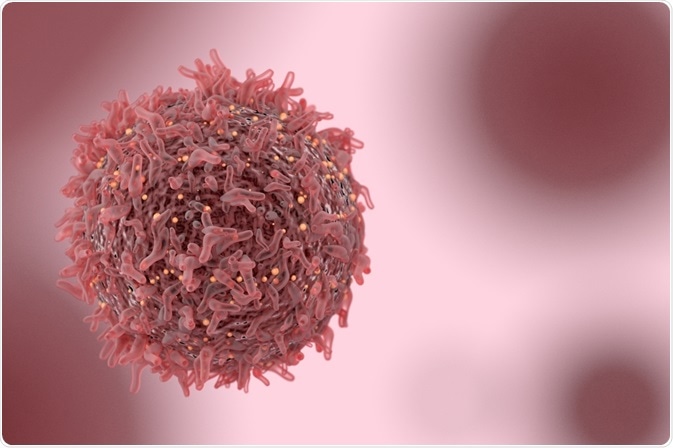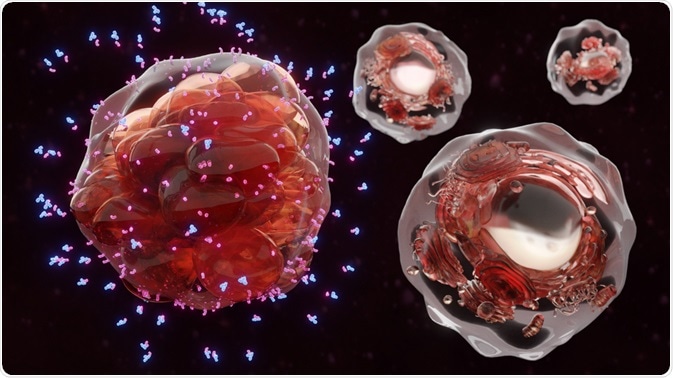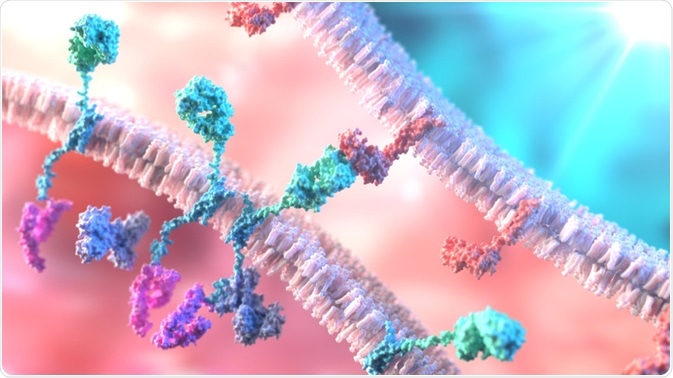Cancer is the second leading cause of mortality worldwide. While conventional anticancer therapies have offered a way to improve the life expectancy and quality of life for many cancer patients, their drawbacks of drug-resistance and side effects are well-documented.

Image Credit: CI Photos/Shutterstock.com
Biotherapeutics look to offer a way forward in the fight against cancer, but what do we mean by biotherapeutics and how do they work?
What is biotherapeutics?
Biotherapeutics are therapies that rely on natural biological substances, including cells and their products.
Conventional anticancer treatments, such as chemotherapy and radiotherapy, can use semi-synthetic or synthetic, low-selective, and toxic compounds. Biotherapeutics hope to improve biocompatibility, offering alternative, effective and safer anticancer treatments.
Broadly, biotherapeutics may be used to target, label, or alter cancer cell function, either directly by affecting the cancer cells, or indirectly by altering the immune system to remove the cancer cells.
The classification of biotherapeutics can become blurred, as many treatment strategies crossover into multiple areas. But anticancer biotherapeutics will always involve the use of one or more of genes, proteins, whole cells, or viruses.
Cancer and the immune system
Before looking at biotherapeutic strategies, consideration should be given to the role of immune avoidance in cancer progression. As the immune system is capable of clearing cancer cells, avoiding immune detection is critical for cancer cell growth and survival.
While there are a variety of methods that cancer cells can use to avoid immune clearance, some common techniques include:
- Upregulating checkpoint protein expression
- Reducing and/or altering tumor antigen presentation
- Stimulating immune-suppressing cells, such as Treg cells
- Inducing T cell tolerance by lack of expression of costimulatory signals
Many of the cancer biotherapeutics that are in development look to overcome these immune avoidance systems by training or altering the immune system to recognize and destroy the cancer cells.
Consequently, immunotherapy-based techniques play an active role in biotherapeutic research.

Image Credit: Alpha Tauri 3D Graphics/Shutterstock.com
Cancer biotherapeutics: proteins
Cytokines are proteins produced by white blood cells and are involved in immune regulation, with both stimulatory and inhibitory effects. Cytokines can restrict cancer progression by stimulating immune cells to destroy the cancer cells or by stopping the growth and promoting pro-apoptotic effects through interactions with the cancer cells.
Interleukins (ILs) and interferons (IFNs) are two groups of cytokines that have become key players in cytokine cancer biotherapeutics, with IL-2 and IFN-a used in the clinics to treat melanoma.
Antibodies can be used in the traditional sense of tagging cells for immune clearance or can be used as inhibitors. As mentioned above, cancer cells can reduce or alter their tumor antigen presentation so that the immune system does not recognize the cancer cells.
To combat this, antibodies that recognize the cancer cells can be generated and inserted into the patient, which attach to the cancer cells and signal to the immune system where the cancer cells are.
Alternatively, antibodies can be used to block cancer cell signaling. This may involve blocking receptors involved in cancer growth or survival, including immune suppression receptors like immune checkpoint proteins.
Immune checkpoint proteins, such as programmed cell death 1 receptor (PD-1) and cytotoxic T-lymphocyte-associated protein 4 (CTLA-4), are found on the surfaces of T cells, and negatively regulate the immune response when activated.
Cancer cells overexpress surface proteins that activate these immune checkpoint proteins, which suppress the immune response. Antibodies have been designed as immune checkpoint inhibitors, blocking signaling by the cancer cells, and stopping immune avoidance.
Limitations of protein biotherapeutics can involve resistance and low effectivity. One strategy that has shown promise to overcome these limitations has been by combining multiple biotherapeutics during treatment, either through multiple antibodies/cytokines or antibodies and cytokines together.
Cancer biotherapeutics: cells
Cell-based cancer biotherapeutics are largely based on modifying immune cells for the targeted killing of the cancer cells, with a focus placed on T cells.
Although, some patients have immune cells that already recognize the cancer cells, such as tumor-infiltrating lymphocytes (TILs), but lack sufficient TIL numbers for effective tumor clearance. For this, TILs are removed from the patient, increased in numbers, and then reinserted into the patient.
For patients that lack TILs, a therapy known as engineered T cell therapy can be used. This therapy modifies T cell surface receptors that are responsible for recognizing tumor antigens, which results in cancer cell death once activated. By genetically modifying T cells with new receptors, the T cells can be reinserted into the patient to target and remove the cancer cells.
Two receptors have been explored through engineered T cell therapy: T cell receptor (TCR) and chimeric antigen receptor (CAR). TCR-T cell therapy is more limited than CAR-T cell therapy as TCR-T cell therapy relies on major histocompatibility complex (MHC)-displayed antigens.

Image Credit: Alpha Tauri 3D Graphics/Shutterstock.com
Cancer biotherapeutics: viruses
A group of viruses, called oncolytic viruses, can kill cancer cells by lysing them. Oncolytic viruses may be modified with other biotherapeutics, such as antibodies, to direct the virus to the cancer cells. Once the viruses reach the cancer cells, they gain entry to the cell and replicate, which causes the cell to rupture.
Alternatively, viruses can be genetically engineering with other biotherapeutics, such as cancer antigens or genes. The antigen modified viruses can be used as a vaccine, stimulating the patient’s immune system to attack cancer.
Viruses may also be used to carry genes to the cancer cells, which can activate apoptotic pathways, inhibit growth or alter protein expression, once inside the cancer cells.
Conclusions
While consideration to improving biocompatibility and administration of biotherapeutics will be necessary as research progresses, biotherapeutics offer a promising alternative to conventional anticancer treatments. And using a combination of different biotherapeutics may offer an effective anticancer treatment strategy.
References
- Aldeghaither, D., Smaglo, B. G. and Weiner, L. M. (2015) ‘Beyond peptides and mAbs - Current status and future perspectives for biotherapeutics with novel constructs’, Journal of Clinical Pharmacology, 55(S3), pp. S4–S20.
- Berraondo, P. et al. (2019) ‘Cytokines in clinical cancer immunotherapy’, British Journal of Cancer, pp. 6–1
- Chulpanova, D. S. et al. (2018) ‘Recombinant viruses for cancer therapy’, Biomedicines, 6(4), pp. 94.
- Cruz, E. and Kayser, V. (2019) ‘Monoclonal antibody therapy of solid tumors: Clinical limitations and novel strategies to enhance treatment efficacy’, Biologics: Targets and Therapy, 13, pp. 33–51.
- Johnson, D. E. (2018) ‘Biotherapeutics: Challenges and opportunities for predictive toxicology of monoclonal antibodies’, International Journal of Molecular Sciences, 19(11).
- Lee, S. and Margolin, K. (2011) ‘Cytokines in cancer immunotherapy’, Cancers, 3(4), pp. 3856–3893.
- Raja, J. et al. (2018) ‘Oncolytic virus immunotherapy: Future prospects for oncology’, Journal for Immunotherapy of Cancer, 6(1), p. 140.
- Vinay, D. S. et al. (2015) ‘Immune evasion in cancer: Mechanistic basis and therapeutic strategies’, Seminars in Cancer Biology, 35, pp. S185–S198.
- Zhao, L., and Cao, Y. J. (2019) ‘Engineered T Cell Therapy for Cancer in the Clinic’, Frontiers in Immunology, 10, p. 2250.
Further Reading